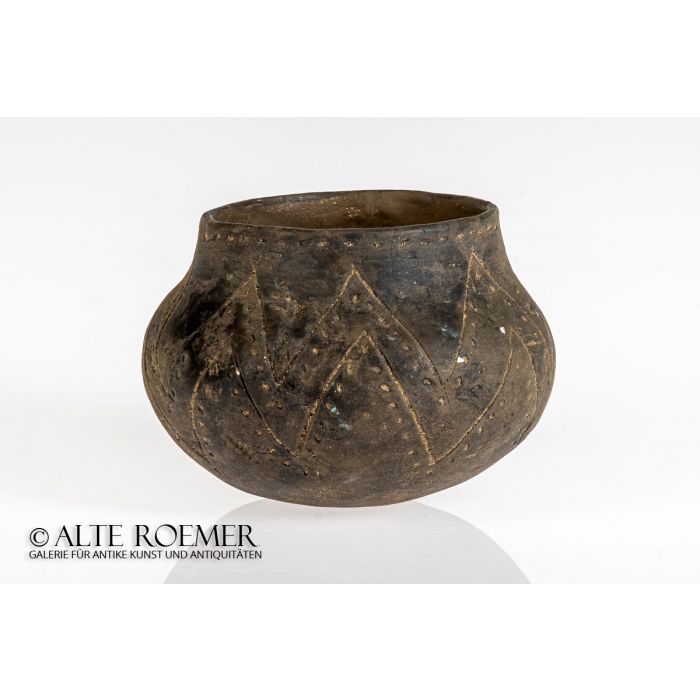Vessel of the Linear Pottery culture
Price: on request
Sold
Object number
AR2693
| Object: |
Vessel decorated with linear patterns
|
| Material: |
Clay.
|
| Period: |
Linear Pottery culture, 5200 BC to 4900 BC. European Neolithic. |
| Description: |
Small spherical vessel with rounded base. The short neck is directed straight upwards. The surface is decorated by a linear pattern. This piece is tableware or cookware from the earliest peasants of Central Europe.
|
| Background: |
Everything changed with the Linear Pottery culture (also known as Linear Band Ware culture). They were the first real peasants of Central Europe and had permanent settlements, solid houses, wells, specialized tools for agriculture and pottery production on a grand scale. It is hard to imagine the cultural shock they must have given the contemporary nomadic peoples. This conflict is at the root of civilization and thought to be reflected in the bible, where Cain murders Abel. The farmer defeats the nomad. But the Neolithic Revolution also left more tangible traces. Some of the earliest pottery survived the ages, like the well-preserved vessel presented here. When archaeologists found such pottery they labled it linear band ware (German "Bandkeramik"), because of the characteristic patterns made of angled, spiral or wavy lines. The name was then transfered to the culture that spawned such pottery and brought the Neolithic Revolution to Central Europe. |
| Dimensions: |
109mm height, c. 135mm diameter.
|
| Condition: |
Almost perfect condition. Very nice preservation of the decorated surface. It is possible that there are small restorations impossible to spot, because they were extremely well performed. Slip on the inside. The condition is very rare for a vessel from the early Neolithic.
|
| Provenance: |
Acquired by us in 2019 from the German Rehorik family collection. The collection was built in the 1960ies and 1970ies by Hugo Rehorik. It consists entirely of archeological finds from the region around Regensburg in Germany. Hugo Rehorik (1905-1979) was working in the Regensburg area as an voluntary archeologist, mostly together with Hans-Jürgen Werner (1941-1997) and with the help of Gerhard and Robert Pleyer. The team supported the Landesamt für Denkmalschutz (state department of cultural heritage preservation) with the recovery of artefacts. This support was of great importance because the 1960ies saw the advent of deep plowing in Germany. Artefacts in the ground needed to be saved from destruction by the new agricultural machines quickly. The state archeologists praised this cooperation highly. It is a nice example of volunteers and professionals working together to preserve our cultural heritage. And also a role model urgently needed for today's situation in archeology. The finds were documented and examined according to scientific standards. Intricate restorations were performed by Heinz Rademacher (1929-1992) who worked for the städtische Museum Regensburg (city museum of Regensburg). Most pieces were then given to museums, namely the Historische Museum in Regensburg (Regensburg historical museum), the Naturkundemuseum Regensburg (Regensburg natural history museum) and the archäologische Staatssammlung in München (archeological state collection of Munich). Individual pieces have been split among the volunteers with the consent of the state archeologists. This way the Rehorik collection came into existence. |
| References: |
Cf. Björn-Uwe Abels, Frühe Kulturen in Oberfranken, p. 17, top 2nd from left, middle 3rd f. l., bottom 3rd and 11th f. l. Cf. Musée Unter Linden, vessels from the „Zapfenloch“ excavation of 1965. |
| Literature on the Rehorik collection: |
S. Kuchlmayr, Vom Tertiär zur Römerzeit: Hugo Rehorik u. seine Funde, in Regensburger illustriertes Stadtmagazin no. 3 / 5 (1979), pages 14f. A. Stroh, Bericht der vorgeschichtlichen Abteilung des Museums Regensburg (1965), mentions Hugo Rehorik's relation to numerous finds and research results; Stroh is praising Rehorik's contributions as an amateur archaeologist. F. D. Davis, Neue bandkeramische Gräber von Mangolding (1968), the book deals among other topics with an excavation in which Hugo Rehorik took part in. H. T. Fischer, Archäologische Ausgrabungen und Funde in der Oberpfalz (1982) mentions Hugo Rehorik and explains how thankful the local archaeologist are for their volunteers. T. Fischer, Im memoriam Hans-Jürgen Werner, in Acta Albertina Ratisbonesia 50/2, pages 231ff (1997), the memorandum includes a very good summary of the cooperation with Hugo Rehorik and the situation and working methods in the 1960ies and 1970ies. |
| Authenticity: |
We unconditionally guarantee the authenticity of every artefact, all items are subject to our lifetime return policy on authenticity.
|


